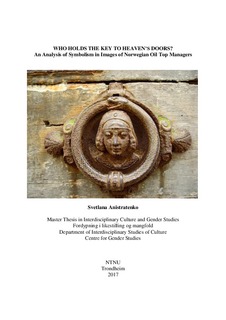Who holds the key to heaven's doors? An Analysis of Symbolism in Images of Norwegian Oil Top Managers
Master thesis
Permanent lenke
http://hdl.handle.net/11250/2455924Utgivelsesdato
2017Metadata
Vis full innførselSamlinger
Sammendrag
This thesis investigates symbolic aspects of gendered power relations in images produced by the Norwegian petroleum giant Statoil ASA (henceforth “Statoil”). Large organizations such as Statoil are amongst the significant power structures that generate images. These images construct gendered power relations in society. Analysis of the images that are produced by such organizations can provide significant insights into the workings of gendered power relations.
The main question that is examined in this thesis is: What symbolic allusions of gendered power are generated by the visual representations of Statoil’s presidents in the images featured on its corporate website, www.statoil.com. To examine this question, I map the symbolism of three image categories: images that capture the signing of international agreements, images taken off-shore and portraits of the company’s presidents.
I chose Statoil as a subject because this multinational petroleum company plays a central role in the Norwegian economy. My other reason for choosing Statoil was that the company (through its 45 years of history) has never had a female president. Its present corporate executive committee consists of eight men and two women. This constitution actualizes the question of gendered power imbalance, both in the Norwegian petroleum industry and the more general sphere of Norwegian industry.
My main theoretical approach is hermeneutics—or, more accurately, hermeneutic symbols theory. Following Geertz (1973), I approach culture as a system of meanings embodied in symbols. Symbols are a core analytical tool. I use them to explore and interpret cultural meanings. Similar to Solheim (1998, 2004), I approach gender as a key symbol of culture and society. In addition, I employ neo-Marxist ideas about power dynamics in modern society.
When examining the images, I draw predominantly on semiotic visual analysis, following Roland Barthes’ semiotic model of “decoding” and “reading” images.
The thesis consists of seven chapters: an introduction, a theory chapter, a method chapter, three chapters that describe the analysis of images and, finally, a summary chapter.
